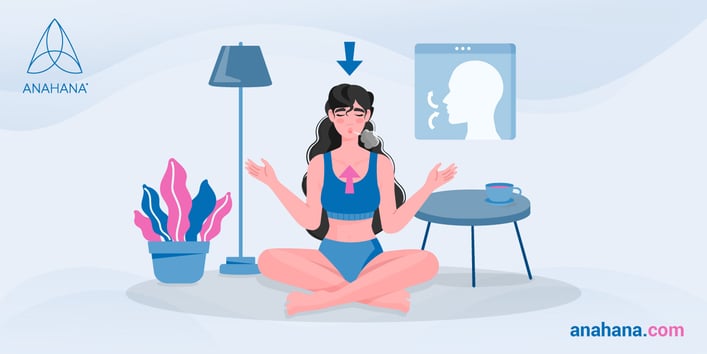
Table of Contents
Alternate nostril breathing is a very common traditional yogic breathing technique. It is also referred to as Nadi Shodhana Pranayama, where Nadis are subtle energy channels and Shodhana means cleansing or purifying.
What is Alternate Nostril Breathing?
In Sanskrit, this technique is also known as Anuloma Viloma. Pranayama, which means breath control, is the fourth limb of the Yoga Sutras and establishes a profound awareness and integration of the mind, body, and breath. It enables emotional calmness, mental clarity, and spiritual connection.
The term is derived from several Sanskrit roots: prana, meaning “vital life force,” -yama, meaning “control'' and -ayama, meaning “extension.”
Since the breath is a source of prana, pranayama can be understood as a method to build and expand this energy through the conscious, intentional control of respiration.
Alternate nostril breathing is a breathwork exercise that involves deliberately closing one nostril at a time to channel the breath through one side of the nasal passage, promoting balance and relaxation in the body and mind.
Alternate nostril breathing is one of the yogic breathing exercises most commonly incorporated into yoga and meditation practice. In the yogic tradition, alternate nostril breathing is a technique for aligning the body and mind. Modern science has also proven its benefits to the brain and nervous system.
Benefits of Alternate Nostril Breathing
Alternate nostril breathing techniques have many benefits, including balancing the brain's hemispheres, regulating the autonomic nervous system, fostering the mind-body connection, increasing emotional control, and reducing stress.
- Connecting the mind, body, and breath: Alternate nostril breathing cultivates a deep connection between the mind, body, and breath, fostering inner balance. Traditional yogic practice balances and aligns the brain's left and right hemispheres and the body's sides through the breath.
- Brain Balance: Since each nostril connects to the opposite side of the brain, you can balance the activity in the two hemispheres of the brain, and the result is an amazing sense of calm alertness
- Emotional Control: Each nostril has different emotional and sensual control over the mind and body. The left nostril, the Ida, is considered a more feminine channel. It is said to have a cooling presence more inwardly nurturing and representative of the moon. The right nostril is the Pingala, connecting to the masculine presence. It is thought to be related to the sun. However, too much control by the Pingala can lead to over-assertiveness, agitation, and a lack of concentration.
- Decreased Stress and Anxiety: Alternate nostril breathing helps to soothe and prevent anxiety by activating the parasympathetic nervous system and counteracting the stress response.
What is the Difference Between Anuloma Viloma and Nadi Shodhan?
Nadi Shodhan and Anuloma Viloma are both types of alternate nostril breathing exercises, but they differ in their technique.
During Anulom Vilom, you breathe in through the left nostril and exhale through the right, then reverse the process by inhaling through the right nostril and exhaling through the left.
The second alternate nostril breathing exercise, Nadi Shodhana, involves inhaling through the left nostril, then holding the breath (Kumbhak means to retain the breath), and exhaling through the right nostril.
The second round involves inhaling through the right nostril, holding the breath, and exhaling through the left nostril.
In Anulom Vilom, there is no requirement to hold your breath, whereas in Nadi Sodhan, it is necessary to retain the breath for as long as possible. If just beginning, you can follow a breathing pattern of inhaling for two seconds, holding for four seconds, and exhaling for four seconds.
Both practices are believed to purify the body and mind and balance the flow of prana (subtle life-force energy) in the body.
How Does Alternate Nostril Breathing Work?
Both of our nostrils are linked to opposite sides of the brain. The focus of inhaling through the left nostril aims to stimulate the right side of the brain, while inhaling through the right nostril seeks to awaken the left side.
Just like our circadian rhythm that affects our sleep cycle, we also have an ultradian rhythm that affects our nasal cycle, breathing, and brain function.
This nasal cycle alternates between congestion and decongestion in the tissues of each nostril, which leads to a change in the airflow on that side. The nasal cycle lasts 25 minutes to two or three hours in a healthy individual.
It is related to the ultradian rhythm and the cerebral dominance of the left or right brain hemispheres, lasting one to three hours.
This alternating rhythm of cerebral dominance plays an important role in:
- Cognitive performance
- Memory processes
- Mood
- Behavior
The autonomic nervous system controls the nasal cycle and alternating dominance of the left and right cerebral hemispheres. When we intentionally control the airflow through both nostrils in practices like alternate nostril breathing, we can balance the nervous system, the brain and the mind.
Who Should Try Alternate Nostril Breathing?
Alternate nostril breathing is a calming practice suitable for many individuals.
It can be particularly beneficial for anyone experiencing chronic stress, including those with generalized anxiety disorder, individuals with demanding or stressful jobs, or even those facing nerve-wracking situations like public speaking engagements.
Regardless of one’s background or circumstances, incorporating alternate nostril breathing into a daily routine can help promote a sense of calm and well-being.
Contraindications of Alternate Nostril Breathing
Alternate nostril breathing practice may not suit individuals with high blood pressure or respiratory conditions.
This is because people with elevated blood pressure should avoid breath retention, as it can temporarily raise blood pressure due to increased circulation needed to supply the brain with oxygen during the brief pause in respiration.
Individuals with respiratory diseases or illnesses like asthma should also use caution when performing alternate nostril breathing exercises. The airflow redirection may cause a baroreflex response that can mimic or induce an asthma attack.
Listening to one's body is important when practicing alternate nostril breathing or any other breathing technique. Immediately end the practice if one feels dizzy, lightheaded, or nauseous.
It is always recommended to consult a physician or healthcare provider if one has concerns about starting alternate nostril breathing.
How to Practice Alternate Nostril Breathing

The alternate nostril breathing technique involves alternating the flow of breath between the left and right nostrils to promote relaxation and balance. It consists of five main parts.
In Sanskrit, Poorak means to inhale, Rechak means to exhale and release the breath, and Kumbach means to pause and retain the breath to integrate the prana. Here is the step-by-step process:
- Inhale Right (Poorak)
- Close that nostril (Kumbach)
- Exhale Left (Rechak)
- Inhale Left (Poorak)
- Close that nostril (Kumbach)
- Exhale Right (Rechak)
These five components can be performed at one's own pace and readily adapted to individual capabilities and comfort levels.
With each inhalation, one can introduce a brief hold or pause to facilitate the natural rhythm of their breath.
Before detailing the steps for alternate nostril breathing, the guide offers some valuable recommendations for creating an optimal environment to engage in these breathing exercises.
Find a Quiet Location
Alternate nostril breathing doesn't require a specific location or props, but practicing alternate nostril breathing in a quiet and private environment is beneficial.
The entire practice typically takes only five to ten minutes, so allocate some dedicated time to focus on one’s breath and mental alignment away from other commitments or distractions.
Get Comfortable
We recommend you find a comfortable position to hold that posture without strain for around ten minutes. A meditation cushion or cozy chair is the perfect location for gentle breathwork.
Step 1: Inhale
Once you are seated comfortably, ensure that you are sitting upright and breathing normally.
After a few cycles of regular breathing, begin breathing exclusively through the nose. Gently close your mouth and rest your lips in a relaxed position.
As you breathe into your nostril, pay extra attention to the inhale. On your next cycle, inhale fully, allowing the body to pause naturally. During this stop, you will begin to alternate.
Step 2: Pinch
Begin by gently raising your right hand and resting your right thumb against your right nostril. Place gentle pressure, ensuring the airway is closed and you feel no discomfort.
Allow your left hand to rest in your lap or comfortably on the floor beside you. If practicing for five to ten minutes, that arm can be used like a shelf to support the other arm holding your nose.
Step 3: Exhale
While your right nostril is closed, exhale fully through the left nostril, allowing the body to pause as the exhale is completed naturally. Without straining, try to exhale the entire contents of the lungs.
Step 4: Inhale
Take a deep breath through the left nostril, permitting the ribs to expand and move outward. Do it slowly.
Step 5: Hold
At the height of the inhale, gently hold the left nostril closed with the ring finger of your right hand, or as some people prefer, the index and middle finger.
Step 6: Exhale
Release your thumb from your right nostril and exhale fully, allowing a natural pause at the end of the exhale. Then, inhale slowly and deeply through the same nostril.
Step 7: Repeat
Repeat steps one through five for at least five minutes. As you become more comfortable with the practice, increase the duration for just a few minutes.
As a beginner, aim to inhale and exhale at the same time. With this approach, you can increase the exhale length until it is double that of the inhale.
References
Joyous Mind: The Practice of Nadi Shodhanam (Alternate Nostril Breathing)
What to Know About Alternate-Nostril Breathing.
Disclaimer
The contents of this article are provided for informational purposes only and are not intended to substitute for professional medical advice, diagnosis, or treatment. It is always recommended to consult with a qualified healthcare provider before making any health-related changes or if you have any questions or concerns about your health. Anahana is not liable for any errors, omissions, or consequences that may occur from using the information provided.

By: Meriah McCauley
Meriah McCauley is a leading voice in holistic healing, known across North America for her expertise in chakra balancing, spiritual alignment, and energy-based wellness. Her work bridges the art and science of mind-body healing, shaped through years of study, practice, and mentorship. Meriah deepened her understanding of spiritual anatomy and the chakra system under the guidance of her guru, Dr. Don Stapleton, during her immersive training in Costa Rica. She later earned her Master’s degree in Psychology from Columbia University, specializing in Spirituality and the Mind–Body connection, which continues to influence her integrative approach. Today, she supports individuals and practitioners through coaching, yoga teacher trainings, chakra-focused education, and Holotropic Breathwork for personal transformation. Meriah is dedicated to helping others develop emotional clarity, energetic balance, and spiritual resilience—and she remains committed to guiding anyone seeking a deeper, more meaningful connection with themselves.